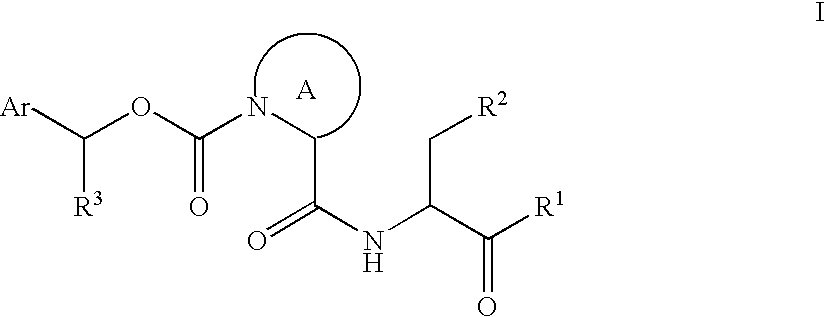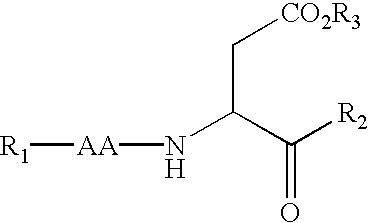Caspase inhibitors and uses thereof
a technology of caspase inhibitors and inhibitors, applied in the field of medicinal chemistry, can solve the problems of undesirable pharmacological properties of peptide inhibitors, poor oral absorption, and inability to reflect potency in cellular models, and achieve the effects of improving cell penetration and pharmacokinetic properties, good efficacy, and potent inhibition properties
- Summary
- Abstract
- Description
- Claims
- Application Information
AI Technical Summary
Benefits of technology
Problems solved by technology
Method used
Image
Examples
example 1
[0105]
Trifluoroacetic acid (TFA) (12 mL ) was added to a stirred ice cold solution of [3S / R,(2S)]-3-(1-benzyloxycarbonyl-2-piperidinecarboxamido)-5-fluoro-4-oxo-pentanoic acid tert-butyl ester (698 mg, 1.55 mmol) in anhydrous DCM (38 mL). The mixture was stirred at 0° C. for 0.5 h then at room temperature for 0.5 h. The mixture was concentrated under reduced pressure and then the residue was dissolved in dry DCM. This process was repeated several times in order to remove excess TFA. The gum was lyophilized twice from HPLC grade water / acetonitrile to afford the title compound as a white solid foam (481 mg, 79%): IR (solid) 1736, 1665, 1517, 1436, 1255, 1174, 1041, 931 cm−1; 1H NMR (400 MHz, d6-DMSO) δ 1.12–1.40 (2H, m), 1.45–1.68 (3H, m), 2.05 (1H, m), 2.61–2.63 (1H, m), 2.70–2.87 (1H, m), 2.98–3.21 (1H, m), 3.91 (1H, m), 4.28–4.75 (3H, m), 4.91–5.30 (3H, m), 7.25–7.42 (5H, m), 7.80–8.59 (1H, brm), 12.5 (1H, brs); 13C NMR (100 MHz, d6-DMSO) δ (DMSO) 20.0 (CH2), 24.6 (CH2), 27.3 (CH2)...
example 2
[0110]
This was prepared from (S)-1-(2-chlorobenzyloxycarbonyl)-piperidine-2-carboxylic acid methyl ester using procedures similar to those described above in Methods B–E (161 mg, 70% last step): IR (solid) 1668, 1789 cm−1; 1H NMR (400 MHz, d6-DMSO) δ 1.1–1.8 (5H, m), 2.0–2.2 (1H, m), 2.4–2.9 (2H, m), 3.0–3.5 (1H, m), 3.8–4.0 (1H, m), 4.2–4.8 (3H, m), 5.0–5.4 (3H, m), 7.3–7.6 (4H, m), 7.8–8.7 (1H, m), 12.0–13.0 (1H, br s); 13C NMR (100 MHz, d6-DMSO) δ 20.50, 20.77, 25.01, 25.14, 27.80, 28.18 (CH2), 33.40, 35.20 (CH2), 42.71 (CH2), 47.89, 48.05, 52.65, 52.91, 53.35, 54.82, 55.05 (2×CH), 64.66, 64.77 (CH2), 81.94, 82.04, 83.70, 83.80, 85.60 (CH2), 128.21, 130.11, 130.18, 130.40, 130.61 (ArCH), 133.08, 134.93, 134.95 (ArC), 155.72, 156.40, 171.72, 172.20, 172.39, 172.58, 172.65, 173.83, 203.14, 203.29 (CO); 19F NMR (376 MHz, d6-DMSO) δ−226.6, −226.8, −226.9, −230.2, −230.4, −232.4, −232.6, −232.6; Low Res MS ES+ 429.4, ES− 427.5.
[3S / R,(2S)]-3-(1-Benzyloxycarbonyl-1,2,3,4-tetrahydro-quin...
example 3
[0111]
This was prepared from (S)-1-benzyloxycarbonyl-1,2,3,4-tetrahydro-quinoline-2-carboxylic acid (U.S. Pat. No. 4,461,896) using procedures similar to those described above in Methods C–E (142 mg, 100%): IR (solid) 2981, 1684, 1653, 1522, 1492, 1394, 1323, 1207, 1053, 1018; 1H NMR (400 MHz, d6-DMSO) □ 1.71 (1H, m), 2.29 (1H, m), 2.31–2.88 (4H, m), 4.00–5.30 (6H, m), 6.97 (1H, m), 7.12 (2H, m), 7.38 (5H, m), 7.69 (1H, m), 8.25+8.62+8.72 (1H, 3×m); 13C NMR (100 MHz, d6-DMSO) δ 26.07, 26.20 (CH2), 28.52, 28.76, 28.95 (CH2), 35.13, 35.34 (CH2), 52.54, 52.84, 53.21 (CH), 58.31, 58.35 (CH), 84.73 (FCH2, J 177 Hz), 124.34, 126.96, 128.27, 128.39, 128.45, 128.49, 128.55, 128.78, 128.83 (CH), 132.19, 12.41 (C), 137.04, 137.78 (C═O), 154.98 (C═O), 172.66, 172.73 (C═O), 203.00, 203.15, 203.29 (FCH2C═O); 19F NMR (376 MHz, d6-DMSO) δ−226.59 (t, J 45 Hz), −226.91 (t, J 45 Hz), −232.76 (t, J 45 Hz).
[3S / R,(2S)]-5-Fluoro-4-oxo-3-(1-(2-trifluoromethylbenzyloxycarbonyl)-2-piperidinecarboxamido)-pen...
PUM
| Property | Measurement | Unit |
|---|---|---|
| temperature | aaaaa | aaaaa |
| concentration | aaaaa | aaaaa |
| humidity | aaaaa | aaaaa |
Abstract
Description
Claims
Application Information
 Login to View More
Login to View More - R&D
- Intellectual Property
- Life Sciences
- Materials
- Tech Scout
- Unparalleled Data Quality
- Higher Quality Content
- 60% Fewer Hallucinations
Browse by: Latest US Patents, China's latest patents, Technical Efficacy Thesaurus, Application Domain, Technology Topic, Popular Technical Reports.
© 2025 PatSnap. All rights reserved.Legal|Privacy policy|Modern Slavery Act Transparency Statement|Sitemap|About US| Contact US: help@patsnap.com



